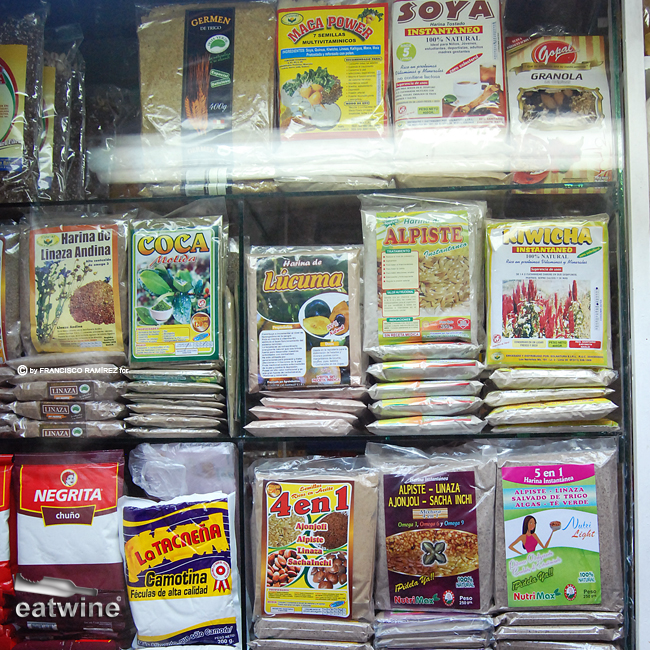CamuCamu: This edible fruit grows in a small, bush-like tree in the Peruvian flooded rainforest and is harvested by canoe. The fruit is a bright reddish-purple color, which imparts an attractive pink tint when juiced. Locals love CamuCamu for its mood elevating properties and remarkably high concentration of Vitamin C and bioflavenoids. The fruit itself is quite acidic, so it is often juiced, diluted and sweetened when used raw. Other ways of preparing and eating CamuCamu consists of drying and sweetening it, candying it, or using it to make tea.
Sacha Inchi: In Quechua, the language of the Incas, Sacha Inchi means “The People’s Seeds.” Grown on vines in the Peruvian Amazon, Sacha Inchi is harvested from star-shaped seed pods. These seeds have been consumed by indigenous tribes dating back to the Incas for its health giving properties. Sacha Inchi has some of the highest concentrations of Omegas in any known food. In Peru, they have caught on to how delicious these little nuts are when toasted and they are starting to pop up in Lima’s gourmet markets and (drum roll) be exported abroad to the United States. They also are now making extra virgin oil and protein powder from the seeds.
Yacon: Beneath a sprawling, untidy South American plant that grows high in the Andes, the mighty Yacon, with its inherent sweet and juicy crunch, is extensively used in its native habitats as both a delicious food and an effective treatment for various ailments. This root possesses a delicate, fruity sweetness that can be extracted and used as a healthy sugar substitute. Yacon’s greatest attribute is its naturally high content of inulin, a complex sugar that breaks down slowly into fructooligosaccharides (FOS). The high levels of FOS are beneficial since, although Yacon tastes sweet, the sugar of inulin is not digestible and simply passes through the body. Therefore Yacon only contains about half the calories of an average sugar source. Secondly, FOS promotes the production of healthy probiotics within the body, which can contribute to better digestion and colon health.
Quinoa: Quinoa is an Andean supergrain that is not really a grain at all rather, it’s a seed. This is a staple food grown from the coast to high in the Andes (up to 4,000 meters above sea level), and is second in importance after the potato and before maize, due to its high protein content of 18%. Quinoa stacks up to be a perfect food: high in protein, low in carbs, with an 8-pack of essential amino acids. Quinoa is far more versatile than rice and can be converted into risottos, pilafs, and warm or chilled salads made ahead. Many vegans use this as a cornerstone of their diet but it will add much nutrition to anyone’s plate. It comes in red, white, and black (no change in taste), but you must rinse it thoroughly under running water to remove the saponin, a bitter-tasting residue.
Maca: This root of the Lepidiummeyenii grows high in the Central Andean Region of Peru between 4,000 and 4,500 meters of altitude in the state of Junín. Maca has been traditionally used by natives to improve sexuality and fertility. During the Incan empire, maca was appreciated not only as nutritious food, but also as a gift from the gods, along with corn and potatoes. Maca comes in either pill format or a powder that you can easily add to a smoothie. Besides the above-mentioned benefits, it also increases your energy and helps you to recover after a big night out (read hangover); or if you are going out, can protect your stomach. Maca also is greatly helpful for women going through menopause since it helps to strengthen the endocrine glands. Easy does it when putting in a smoothie, the taste is earthy (like a turnip) and more than a tablespoon or two will overpower your drink.
Cacao: Many people consider eating chocolate a “guilty pleasure.” The reputation of chocolate as a junk food should more accurately be attributed to the harmful effects of commercial processing and refining techniques, and the other ingredients commonly added, most notably white sugar. All chocolate is made from the cacao bean. Cacao beans in their natural, unprocessed, unadulterated state are rich in nutrients and extremely beneficial to health. Peru is considered by many to be the birthplace of cacao, along with the region of Ecuador. In Peru, the cacao pods hail from the Peruvian jungle where communities grow (organically) different varieties from the pungent, earthy beans near Ayacucho to the pure white cacao from northern Piura. After being harvested, the cacao beans are fermented and then toasted dry. The beans are protected by a paper-thin shell, which you remove before eating. When the shell is removed, the bean often breaks into small pieces, called nibs. Nibs are the best way to consume cacao for all the health benefits. To give you an idea, cacao has four times as many antioxidants as green tea and many more than blueberries or red wine. It’s delicious in smoothies, cereals, and any dessert where you need a crunch. Contrary to popular belief, cacao does NOT contain caffeine.
Coca: Coca leaves grown high in the Andes may be the raw ingredient for cocaine (after a crazy amount of chemical processing) but they are extremely beneficial to health, particularly for energy and coping with high altitude. When you arrive in Cusco, or any high altitude Andean area, skip the commercial teas and go straight for the leaves. Natives will often chew them (warning: very bitter taste). They also sell coca leaf “flour”, a type of powder that they use in cookies, lozenges, and other baked goods. A tablespoon of that in a glass of water will have you bursting with energy and help offset the effects of the altitude. According to research, the chemical composition of coca leaves is much richer in calories, proteins, fats, carbohydrates, fiber, ash, minerals (calcium, phosphorous, iron, potassium, magnesium, sodium, ascorbic acid, etc.) and vitamins A, C and E than other food plants and infusions.













